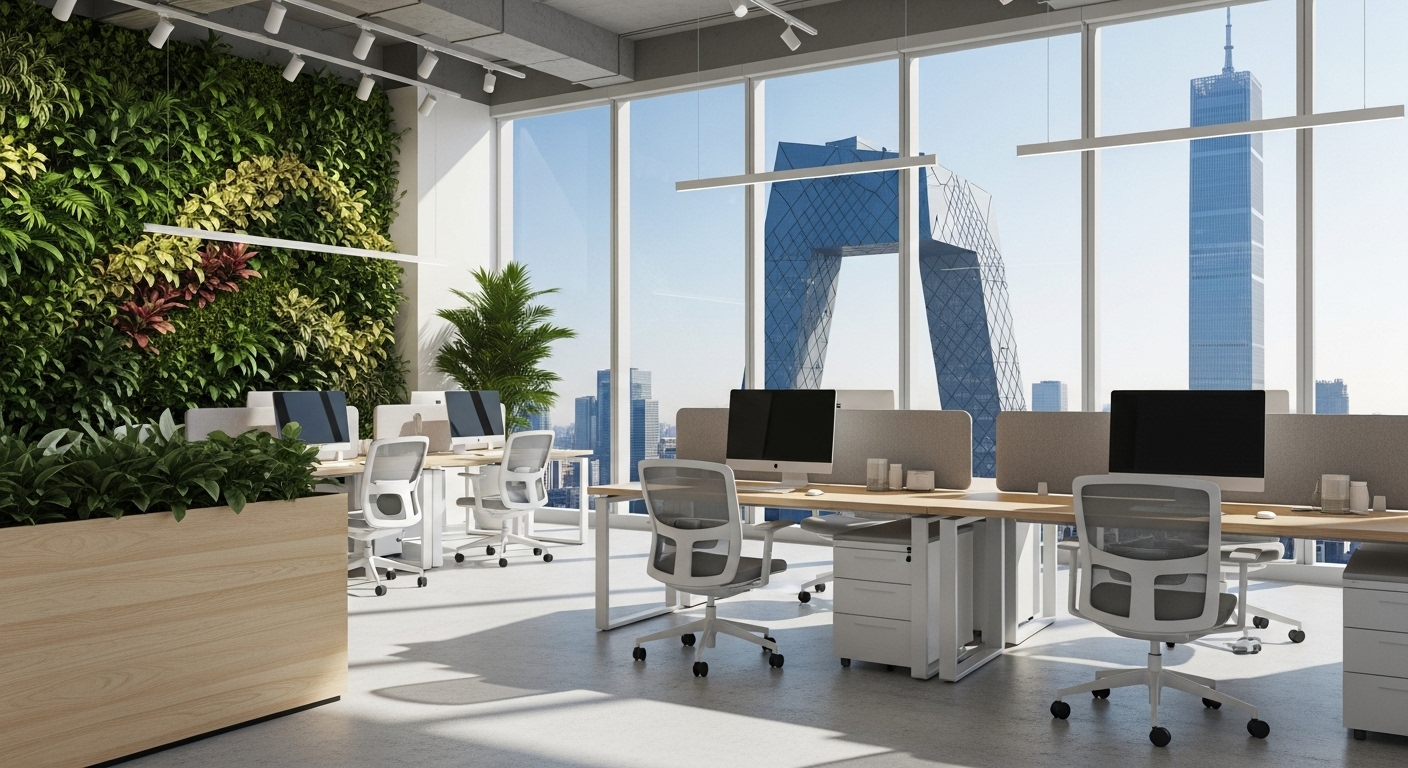Choosing a physical workspace is one of the most significant decisions a business can make. It’s far more than signing a lease; it’s about laying the physical foundation for your company’s culture, productivity, and future growth. In an era where the very definition of ‘office’ has been reshaped, making the right choice has become more complex and more critical than ever. The modern workspace must be a destination—a place that attracts top talent, facilitates collaboration, and embodies your brand’s core values. Simply finding an empty room with desks is no longer enough. A strategic approach is essential to avoid costly mistakes and unlock the full potential of your physical environment. This guide provides a clear, step-by-step framework to navigate this crucial process, breaking it down into three core pillars: analyzing your location, designing the optimal layout, and mastering the complexities of the lease agreement. By focusing on these key areas, you can move beyond guesswork and make an informed decision that will serve as a strategic asset for years to come.
Decoding Your Needs: The Pre-Search Audit
Before you even begin browsing listings, the most critical step is to look inward. A thorough pre-search audit provides the essential data and clarity needed to evaluate potential spaces effectively. Start with your people. How many employees do you have now, and what is your projected headcount growth over the next two to three years? A space that feels perfect today could become cramped and inefficient in twelve months. A common industry benchmark is to budget for 100-175 square feet per employee, but this varies dramatically based on your work style. Next, analyze how your team works. Do they require quiet, focused zones for deep work, or is your culture built around dynamic, open collaboration? A successful layout often incorporates a variety of environments. Your brand identity is another crucial factor. The workspace is a physical manifestation of your company’s values. A sleek, minimalist office in a high-tech building sends a different message than a creative, rustic loft in an arts district. Ensure the space you choose aligns with the brand you want to project to clients and potential hires. Finally, establish a realistic, all-in budget. Your monthly rent is just the beginning. Factor in costs for utilities, insurance, security deposits, IT setup, potential fit-out or construction, and new furniture. Having a clear, comprehensive budget prevents you from overextending financially and allows you to negotiate with confidence.
The Gravity of Place: Mastering Location Strategy
The old real estate adage—’location, location, location’—holds profound truth in workspace strategy. Where your office is located directly impacts talent acquisition, client relationships, and daily operations. The first consideration should be your team’s commute. A difficult or expensive commute is a major cause of employee dissatisfaction. Consider mapping where your employees live to identify a central point that minimizes travel time for the majority. Proximity to public transportation hubs is a significant advantage, expanding your talent pool to those who don’t drive. Next, consider your clients. If you frequently host client meetings, being easily accessible is paramount. Is there adequate parking? Is the office easy to find? The location should be convenient for the people who are critical to your revenue. The character of the neighborhood also plays a vital role in your brand and employee satisfaction. Access to amenities like restaurants, coffee shops, gyms, and parks can make your office a more attractive place to work and creates a more vibrant work-life experience for your team. Don’t underestimate the power of ‘brand adjacency’—being located near other respected or innovative companies can elevate your own company’s stature and create valuable networking opportunities.
Form Meets Function: Designing Your Ideal Workspace Layout
The layout of your office is the engine of its productivity and culture. A poorly designed space can create friction and hinder performance, while a well-designed one can foster innovation and collaboration. The debate is no longer a simple choice between open-plan offices and cubicles. The most effective modern workspaces are agile, offering a variety of zones tailored to different tasks. This concept, known as Activity-Based Working (ABW), empowers employees to choose the setting that best suits their needs at any given moment. Your layout should include dedicated quiet zones for focused, individual work, free from distractions. It also needs dynamic collaboration hubs with whiteboards and flexible seating to encourage teamwork. Social spaces, like a comfortable kitchen or lounge area, are essential for building community and fostering informal interactions that can spark new ideas. Don’t forget the need for private spaces, such as small meeting rooms or phone booths, for confidential conversations and video calls. When planning the layout, prioritize flexibility. Using modular furniture and movable partitions allows you to reconfigure the space as your team’s needs evolve. Elements of biophilic design, such as incorporating natural light, plants, and natural materials, have been proven to boost well-being and reduce stress, making them a worthwhile investment.
The Spectrum of Spaces: From Coworking to Traditional Leases
The type of workspace agreement you choose has significant implications for your finances, flexibility, and operational control. It’s crucial to understand the spectrum of options available. At one end, you have coworking spaces, which offer maximum flexibility with short-term memberships and all-inclusive amenities. These are ideal for startups, freelancers, or companies entering a new market, as they require minimal upfront capital. However, they can lack privacy and offer limited opportunities for custom branding. A step up from this are serviced offices, which provide a private, furnished space with shared services like reception and IT support. They offer more privacy than coworking but come at a higher price point and still have limitations on customization. In the middle are sublets, where you lease space from another tenant. These can be a good deal and often come furnished, but you are subject to the terms of the master lease, which can create instability. At the other end of the spectrum is the traditional lease. This option gives you complete control over the design and operation of your space, allowing you to build a true home for your brand. The trade-off is a long-term commitment, typically 5-10 years, and significant upfront costs for the security deposit, fit-out, and furniture. The right choice depends entirely on your company’s stage, capital, and tolerance for risk.
Navigating the Fine Print: Demystifying the Commercial Lease
For businesses opting for a traditional lease, understanding the document’s fine print is non-negotiable. A commercial lease is a complex legal contract that can contain hidden costs and restrictive clauses. It is highly recommended to engage a commercial real estate attorney to review any lease before you sign. One of the first things to scrutinize is the lease term and any rent escalation clauses, which dictate how much your rent will increase annually. Another critical component is the Tenant Improvement (TI) allowance—a sum of money provided by the landlord for you to customize the space. You must negotiate this amount carefully to ensure it covers your renovation needs. Understand what’s included in your operating expenses, often structured as a Triple Net (NNN) lease, where the tenant pays for property taxes, insurance, and common area maintenance. These can add a significant amount to your base rent.
‘A key negotiation point is the renewal option,’ advises a commercial real estate expert. ‘Securing the right to renew your lease at a predetermined rate protects you from sharp market increases and the massive cost of an unwanted move.’
Also, look for a sublease clause that gives you the flexibility to offload the space if your business needs change, and a break clause that might allow you to terminate the lease early under specific conditions.
Future-Proofing Your Choice: Planning for Scalability and Change
Your workspace decision shouldn’t just solve today’s problems; it must be a platform for tomorrow’s growth. Future-proofing your choice involves embedding scalability and adaptability into your selection criteria from day one. When evaluating a space, don’t just ask if it fits your team now—ask if it can accommodate your projected growth over the next few years. Does the building offer options for expansion? Some landlords offer a ‘right of first refusal’ on adjacent spaces, giving you the first opportunity to lease them when they become available. This can be an invaluable clause for a growing company. Similarly, assess the building’s infrastructure. Is the electrical capacity sufficient for your power needs? Does it have modern, high-speed fiber optic connectivity? Upgrading a building’s core infrastructure later can be prohibitively expensive. The flexibility of your lease is another key component of future-proofing. While landlords prefer long terms, negotiating for a shorter term with renewal options can provide a crucial safety net if your growth trajectory changes unexpectedly. Ultimately, the goal is to select a space that doesn’t constrain your ambition. It should be a flexible container that can evolve with your business, whether that means adding more people, integrating new technology, or adapting to new ways of working.
In conclusion, selecting the right workspace is a multifaceted process that demands careful research and strategic foresight. It requires moving beyond a simple cost-per-square-foot calculation to a holistic analysis of your business’s needs, culture, and long-term vision. The journey begins with a deep internal audit to understand your unique requirements for headcount, work style, and budget. This foundational knowledge then informs your location strategy, ensuring you choose a place that is accessible to both your talent and your clients. From there, the focus shifts to designing a layout that is not just functional but acts as a catalyst for productivity and innovation, providing diverse zones for different types of work. Finally, whether you opt for a flexible coworking arrangement or a long-term traditional lease, a thorough understanding and negotiation of the terms are paramount to protect your financial interests and operational agility. By systematically addressing location, layout, and the lease, you transform a daunting real estate transaction into a powerful strategic decision. The right space becomes more than just an office; it becomes a competitive advantage that fuels your growth and solidifies your identity in the market.





